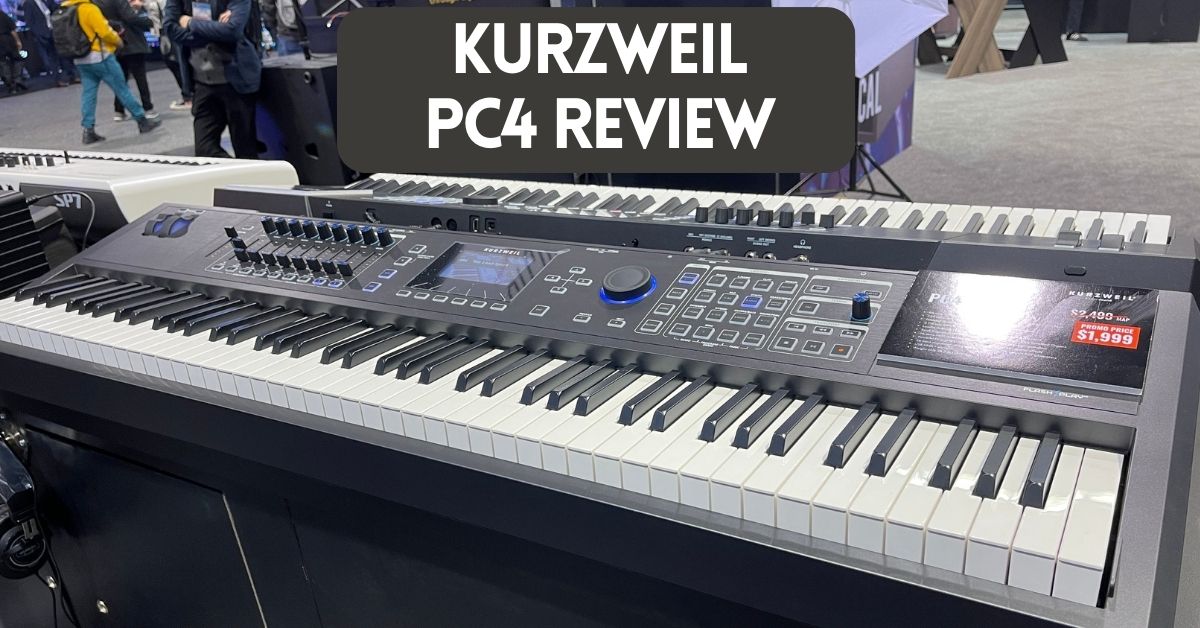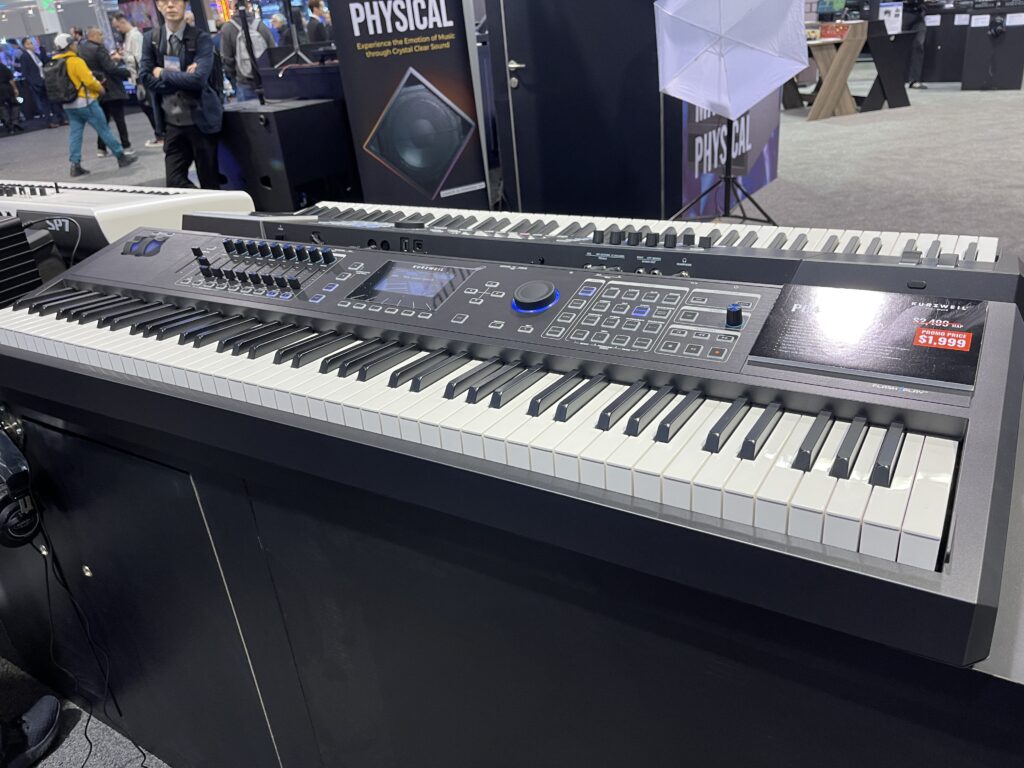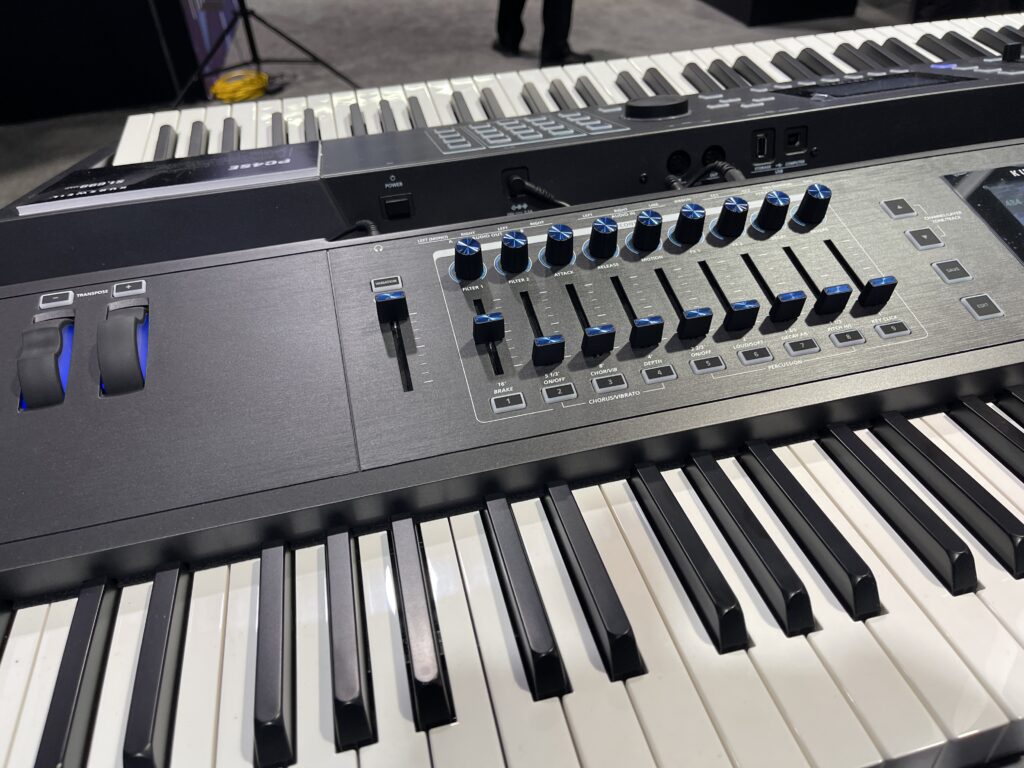Kurzweil PC4 Introduction
Are you looking for a keyboard that can unleash your creativity? Then the Kurzweil PC4 might just be the answer for you. This powerful instrument is a complete package to take your music to the next level. Read on for my Kurzweil PC4 review.
The PC4 was designed with professional musicians in mind and boasts impressive features. Inside are 256 voices of polyphony, a powerful sequencer, and an extensive array of effects. Plus, its intuitive touchscreen interface makes it easy to create complex arrangements and sequences.
A highlight is Kurzweil’s V.A.S.T. synth engine, including a 6-operator FM synthesis option that can import classic FM SysEx files for authentic 1980s keyboard sounds. The sonic palette provides 1000 presets to cover everything you need for music making.
The all-important keybed is 88-notes fully-weighted hammer-action with velocity sensitivity and aftertouch. The workstation is housed in plastic material.
This mid-line Kurzweil keyboard is a workstation that offers more sonic versatility than dedicated stage pianos without the complexity of the Forte-series workstation models.
Azure Hills Music contains affiliate links and is a member of the Amazon Services LLC Associates Program. As an Amazon Associate, we earn from qualifying purchases at no extra cost to you when you purchase using one of these Amazon links. Read our disclaimer and privacy policy for more information.
Link to Buy Kurzweil PC4 88-key Synthesizer Workstation
PC4 Keyboard
The keyboard ranks in the Goldilocks range – not too light or heavy.
As with most keyboards, I recommend finding a model to try to see if the keyboard is adequately responsive for you.
It does offer velocity sensitivity along with aftertouch. Depending on the type of music you create, aftertouch can be a great addition to modify dynamics and modulation.
Interface
A 4.3′ LCD with six soft keys underneath is in the middle of the workstation. The interface is easier to navigate than those in some competitor models.
Sounds
1,000 preset sounds are delivered with the PC4. Additionally, you can access over 50 multis and add 4,096 user versions.
Presets shine with the pad offerings in the PC4.
You can even create your own patches, an area where the Kurzweil PC4 excels.
Specifications
Aftertouch: Included
Arpeggiators: Trigger up to 16 independent arpeggiators (1 per Program, 16 per Multi)
Controls: 2 wheels, 9 sliders, 9 knobs, 10 switches, 2 switch pedal inputs (with support for half-damper pedals), 2 continuous control pedal inputs, aftertouch keyboard, ribbon controller input
Display: 4.3 inch 480×272 color LCD display
Effects: The powerful onboard FX engine with 32 total effects provides chorus, compression, delay, distortion, flanger, phaser, reverb, rotary, and more. A global Master FX section offers 3-band EQ and compression.
FM Engine: 6-operators with the ability to import SysEx files
Keyboard: 88 Medeli weighted hammer-action keys with velocity sensitivity and aftertouch. The action is slightly noisy. Activating the aftertouch requires a bit of firmness from your fingers.
Memory: 2 gigabytes hold 1,000 factory presets divided into 13 program categories. Among the sounds are stunning recreations of a German 9-foot piano and a vintage Japanese 7-foot concert grand piano.
MIDI I/O: In/Out/USB
Organ Engine: KB3 ToneReal organs offers tonewheel recreations with control for nine drawbars, rotary effect with brake, chorus/vibrato, percussion, and more.
Polyphony: 256 voices via the V.A.S.T. polyphony engine. It ranks with the most polyphony ever offered by Kurzweil.
Riff Generators: Ability to trigger and manipulate up to 16 MIDI sequences. Use the internal pattern library or record/import your own.
Samples: Load up to 2GB of custom samples into the PC4 memory. Supported sample formats include WAV, AIFF (up to 16-bit/96kHz), and Kurzweil formats (.P3K, .KRZ, .K25, .K26).
Sequencer: 16-track. Useful to record, edit, and mix your tracks
Storage: USB Flash
String Resonance: The K.S.R. model recreates piano string resonance for realistic acoustic piano sounds.
Transposition: +/- transposition controls available above the pitch/modulation wheels
USB: USB A and B ports allow connection of thumb drives and a computer
V.A.S.T. Editing: Programs include 32 layers, each with a dedicated signal path and modular DSP tools.
Zones: 16 zones provide deep MIDI controller capabilities
Weight: 28.6 pounds
Kurzweil PC4 in use
Boot-up time for the PC4 is just over 20 seconds. At that time, programs are accessible via the LCD screen.
Program selection is available in multiple options, including the alpha dial, category buttons, numeric keypad programming, and program ID number. A Quick Access banks feature functions like a setlist by organizing ten programs that are recalled via a single button. Moving between programs is generally seamless, although transitioning from KB3 organ to V.A.S.T. programs can introduce a brief noise.
It does take some getting familiar with the PC4 to learn which knobs control which parameters for V.A.S.T. programs.
Keyboard splits and layers are accomplished via LCD buttons in Program mode. These bring up the Multi-mode from where you can identify key ranges for your splits and layers. Midi controller options allow for independent transposition of key ranges, velocity curve adjustments, and pedal yes/no transmission parameters.
In programming multis, the underlying programs are what ultimately drive the sound. So as an example, if you program various multis today that use sound #88 and modify program #88 next month, your program change will impact every multi that uses this sound. In addition to the internal sound banks, the Kurzweil PC4 is a functional midi controller.
Sounds
Among the highlights of the internal sounds of the PC4 are the German 9-foot Grand, a robust and dynamic piano. It includes half-pedaling with an appropriate pedal and sympathetic string resonance. There are better acoustic piano emulations on the market, but the PC4 is serviceable. We’ve come a long way since early ROMplers, for sure.
The general keyboard category rounds out with Rhodes and Wurlitzer-style electric piano sounds, Clavinets, and harpsichords.
Organ emulation provides everything you’ll need to knock out Hammond emulation besides access to two keyboard manuals and traditional Hammond action. You also have access to pipe organ sounds. However, suppose you are lucky enough to play traditional pipe or church organ. In that case, you’ll miss the ability to vary registrations via individual stops on the fly – a feature not typically found in modern workstations. The PC4 is no exception.
Orchestral sounds cover all the basics among wind, brass, and string families. You get options for solo instruments, chamber ensembles, and entire sections.
Contemporary sounds include guitars, bass guitars, drum kits, and percussion.
V.A.S.T. Engine
Programs using the V.A.S.T. architecture can accommodate up to 32 functional layers. These contain oscillators (at least 22 virtual analog shapes, FM oscillators with DX7 style 6-operator algorithms, filters, signal processors, and access to program algorithms. You can even access multi-waveforms in the engine. Add on the internal effects, and you can produce a wide range of complex sounds with the PC4.
The downside of the V.A.S.T. architecture is the programming. This is done with dials, cursors, and scrolling between numerical values, with limited interaction of physical knobs. The LCD panel helps with understanding the design of your program. Still, it’s a far cry from the hands-on, old-school analog synthesizer approach to dialing in sounds.
While the PC4 sports 256-voice polyphony, each V.A.S.T. layer uses a voice. So divide the layers of your program by the number of notes you’ll play simultaneously to know the maximum number of notes you can play. For example, a 32-layer program divides into the 256-voice maximum polyphony to yield eight notes maximum at one time.
Onboard KB3 Organ
The KB3 sits in the PC4 as a stand-alone sound engine. As an emulation of vintage tonewheel organs, it integrates a mix of DSP-generated waveforms, samples, and sawtooth waveforms to generate organ sounds. The tonewheel sounds are managed via the LCD screen, where you can shape the organ design to your liking by varying aspects of individual keys or tonewheels.
Samples
Sample-based sounds can be integrated via a USB drive. You can use Kurzweil PC3 and Forte-series samples. Importing your sounds as WAV and AIFF files via a software editor is also possible. My experience with such capabilities is that they typically sound much more interesting and exciting in the sales brochures than the ability to use the functionality in practice. As they say, your mileage may differ.
Arpeggiator
Arpeggiator options include traditional up and down patterns. Additionally, various algorithms provide step-sequenced movements, including velocity and duration variations. Use one of the nearly 150 arpeggiator presets or invent your own.
Sequencer
The Song Mode of the 16-channel on-board sequencer lets you create complete songs with multiple parts. You can even make small sections known as Riffs that you can trigger during your performances. The total memory is nearly 50,000 events per song. A notable limitation is that the editing process has no undo function.
Pros of the Kurzweil PC4
- Weighted hammer-action keybed with velocity sensitivity and aftertouch
- Ample physical controls on the panel
- Robust sound palette to cover most mainstream needs for the working keyboardist
Cons of the Kurzweil PC4
- External power adapter
- Complex programming
Summary
The PC4 fits in easily into everyday performance situations. With all the basics covered, from pianos to synthesizers and orchestral sounds, you can use the PC4 for rock and blues clubs, musical theater gigs, and beyond.
The Kurzweil PC4 competes well with the FA 08, Kronos, and Montage. I would put it under the Nord Stage 4, although the price difference between those two keyboards speaks to this difference.
If you’re looking for a general workhorse keyboard that does an acceptable job in most categories, you will likely be satisfied with the PC4.
Link to Buy Kurzweil PC4 88-key Synthesizer Workstation




